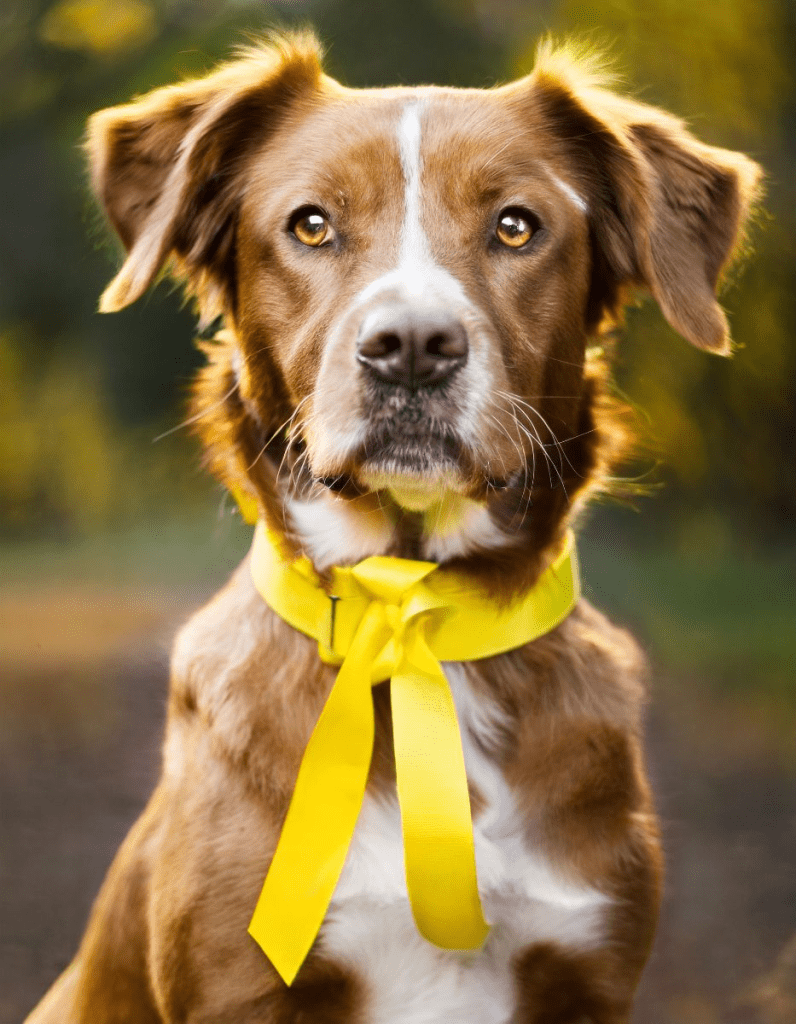When you’re out for a walk and come across an adorable dog, the natural instinct might be to reach out, give it a pat, or let your own pet say hello. But did you know that not every dog welcomes such interactions? For some dogs, close encounters with strangers can be overwhelming or even unsafe. Enter the yellow ribbon—a subtle but powerful signal that conveys, “This dog needs space.” In this article, we’ll dive into what a yellow ribbon on a dog’s collar means, why it’s used, and how to respect it for everyone’s safety and comfort.

The Yellow Ribbon: A Universal Sign of Caution
The yellow ribbon on a dog’s collar or leash is a widely recognized symbol indicating that the dog may need space from people or other dogs. It’s a simple but effective way to communicate that this dog may not be comfortable with close contact or sudden interactions. Although the yellow ribbon’s meaning is becoming more familiar worldwide, not everyone knows what it represents. By understanding this signal, you’re not only helping the dog and its owner but also promoting a safer and more respectful environment for everyone.
Reasons Why a Dog Might Wear a Yellow Ribbon
Every dog has its own personality and comfort level, and a yellow ribbon can indicate a range of reasons why a dog might need extra space. Here are some common reasons why owners choose to mark their dog with a yellow ribbon:
1. Health and Recovery Needs
Some dogs are recovering from surgery, illness, or injury. In these cases, interaction with other dogs or people could disrupt their healing process. For dogs in recovery, even gentle play could risk reopening wounds or causing discomfort, making a yellow ribbon a useful reminder for passersby to keep their distance.
2. Dogs in Training
Many dogs wear a yellow ribbon because they are currently in training. Training requires focus, and unexpected interactions can distract both the dog and handler. Whether it’s a service dog in training or a young puppy learning to walk politely on a leash, a yellow ribbon communicates that the dog needs space to stay attentive to its handler.
3. Anxious or Nervous Temperament
Some dogs experience anxiety or nervousness around strangers or unfamiliar environments. For these dogs, sudden approaches can cause fear or stress, which might lead to undesirable reactions. The yellow ribbon serves as a signal to give these dogs room to feel secure, preventing them from becoming overwhelmed.
4. Older Dogs or Those with Sensory Challenges
As dogs age, they may become less tolerant of interactions and unexpected stimuli. Elderly dogs, or those with sensory issues such as blindness or deafness, can find it unsettling when approached suddenly. The yellow ribbon reminds others that these dogs may startle easily and require a more gentle, distant approach.
5. Rescue Dogs with Trauma Histories
Rescue dogs often come from backgrounds that include neglect, abuse, or other traumatic experiences, making them wary or unpredictable in new situations. These dogs may need time to adjust and can react unpredictably if approached. A yellow ribbon helps signal to others that this dog is still acclimating and may react poorly to sudden interactions.
6. Aggression or Protective Instincts
Some dogs have a history of aggressive or protective behavior, which could be triggered by perceived threats or by people or pets getting too close. For these dogs, a yellow ribbon is an essential safety measure, indicating that they need space to feel secure and prevent potential incidents.
The Yellow Dog Project: Promoting Awareness and Safety

The Yellow Dog Project is a global initiative aimed at educating the public about the yellow ribbon’s significance. This movement advocates for the understanding and respect of dogs who require extra space, encouraging both dog owners and the general public to recognize the importance of this symbol. By raising awareness about the yellow ribbon, the Yellow Dog Project hopes to create safer, more considerate environments for dogs who may feel uncomfortable with close interactions.
Through campaigns and resources, the Yellow Dog Project helps spread the message that not every dog is open to immediate attention. The goal is to foster an understanding that dogs, like people, have unique needs and boundaries that deserve respect.
How to Interact with a Dog Wearing a Yellow Ribbon
If you see a dog with a yellow ribbon or any yellow marking on its collar or leash, the best response is to maintain a respectful distance. Here are some guidelines to follow:
- Keep Your Distance: Avoid approaching the dog directly or allowing your own pet to approach. A yellow ribbon means that the dog may not be comfortable with close contact.
- Ask the Owner: If you’d like to interact, it’s polite to ask the owner from a distance if it’s okay to approach. They can provide specific instructions or let you know if the dog prefers to be left alone.
- Respect the Dog’s Space: Even if you’re an experienced dog lover, always wait for permission before engaging with a dog wearing a yellow ribbon. This simple act of respect can prevent stress for the dog and ensure everyone’s safety.
The Importance of Recognizing and Respecting a Dog’s Needs
Understanding the yellow ribbon symbol isn’t just about protecting dogs; it’s also about promoting empathy and respect in shared spaces. Just like people, every dog has its own comfort level, and recognizing their boundaries helps build a more considerate community. For dogs with specific needs, even the most well-intentioned interaction can be overwhelming. By honoring the yellow ribbon, you’re helping to create a safe environment for everyone.
Why the Yellow Ribbon Benefits Everyone
While the yellow ribbon primarily benefits dogs who need space, it also enhances the experience of other dog owners, children, and the general public. Here’s how:
- Prevents Stressful Encounters: For owners of anxious or reactive dogs, the yellow ribbon serves as a way to avoid stressful situations, making walks and outings more enjoyable.
- Educates the Public: The yellow ribbon encourages people to be mindful of a dog’s unique needs, fostering a better understanding of responsible pet interactions.
- Creates Safer Spaces: By giving dogs with yellow ribbons the space they need, we can prevent incidents and misunderstandings that may lead to negative experiences for both people and pets.
Promoting Empathy in Shared Spaces
In parks, streets, and trails, the yellow ribbon serves as a gentle reminder to respect the personal space of others. For those who might be unfamiliar with the yellow ribbon, a quick explanation can go a long way in spreading awareness. Each encounter with a dog wearing a yellow ribbon is an opportunity to educate and promote understanding, helping more people learn to respect these important boundaries.
Conclusion: Respect the Yellow Ribbon, Respect the Dog
A yellow ribbon on a dog’s collar isn’t just a decorative touch—it’s a clear request for space and understanding. Whether due to health, temperament, age, or training needs, a dog with a yellow ribbon deserves respect and distance. By honoring this symbol, you’re contributing to a more compassionate community where every dog feels safe, and every owner feels supported.
Next time you’re out on a walk and spot a yellow ribbon, remember that it’s a gentle but firm reminder to give that dog the room it needs. This simple act of understanding can make a world of difference for dogs and their owners alike, fostering safer, more empathetic shared spaces for everyone.


